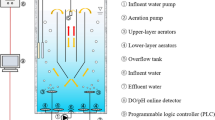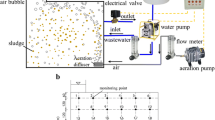Abstract
This study presents an optimal injection method for using carbon dioxide as a carbon source for the hydrogenotrophic denitrification of secondary wastewater effluent in a laboratory-scale fixed bed reactor (FBR). The FBR was operated under three conditions: a continuous CO2 supply, periodic CO2 supply, and without a CO2 supply. The continuous operation of the FBR without carbon dioxide injection resulted in an increase in pH to 10 and a noticeable level of nitrite accumulation. The continuous co-injection of carbon dioxide and hydrogen gas decreased the pH to a range of 6 ∼ 8, but the denitrification efficiency decreased to 29%. The co-injection of carbon dioxide decreased the maximum dissolved hydrogen concentration and hydrogen mass transfer rate by 25 and 61%, respectively. Compared to the continuous injection method, a periodic injection of carbon dioxide increased the denitrification efficiency from 28.6 to 85% as the hydrogen flow rate and hydraulic retention time (HRT) increased. With the periodic injection of carbon dioxide, the nitrite accumulation appeared to be insignificant as the hydrogen flow rate increased.
Similar content being viewed by others
References
Kim, J. H., J. S. Lee, G. B. Jung, S. G. Yun, M. H. Koh, J. C. Shim, and S. K. Kwun (2003) Improvement of water quality standards for Korean agriculture by comparison with foreign countries’ case. Kor. J. Int. Agricult. 15: 179–188.
Friedler, E. (1999) The Jeezrael valley project for wastewater reclamation and reuse. Water Sci. Technol. 40: 43–50.
Zulu, G., M. Toyota, and S. Misawa (1996) Characteristics of water reuse and its effects on paddy irrigation system water balance and the rice land ecosystem. Agricult. Wat. Manag. 31: 269–283.
WHO (2004) Nitrates and nitrites in drinking-water. Rolling revision of the WHO guidelines for drinking-water quality. Draft for review and comments. World Health Organization, Geneva.
Xiong, J., G. Guo, Q. Mahmood, and M. Yue (2011) Nitrogen removal from secondary effluent by using integrated constructed wetland system. Ecologic. Eng. 37: 659–662.
Kaneko, S. and K. Nakajima (1988) Phosphorus removal by crystallization using a granular activated magnesia clinker. J. Water Pollution Control Fed. 60: 1239–1244.
Hashimoto, S. and K. Furukawa (1989) Nutrient removal from secondary effluent by filamentous algae. J. Ferment. Bioeng. 67: 62–69.
Kang, S. K., K. H. Choo, and K. H. Lim (2003) Use of iron oxide particles as adsorbents to enhance phosphorus removal from secondary wastewater effluent. Separation Sci. Technol. 38: 3853–3874.
Kuroda, M., T. Watanabe, and Y. Umedu (1997) Simultaneous COD removal and denitrification of wastewater by bio-electro reactors. Water Sci. Technol. 35: 161–168.
Lee, C. K. and R. E. Rittmann (2002) Applying a novel autohydrogenotrophic hollow-fiber membrane biofilm reactor for denitrification of drinking water. Water Res. 36: 2040–2052.
Schnobrich, M. R., B. P. Chaplin, M. J. Semmens, and P. J. Novak (2007) Stimulating hydrogenotrophic denitrification in simulated groundwater containing high dissolved oxygen and nitrate concentrations. Water Res. 41: 1869–1876.
Ergas, S. J. and A. F. Reuss (2001) Hydrogenotrophic denitrification of drinking water using a hollow fibre membrane bioreactor. J. Water Supply. 50: 161–171
Karanasios, K. A., I. A. Vasiliadou, S. Pavlou, and D. V. Vayenas (2010) Hydrogenotrophic denitrification of potable water: A review. J. Hazardous Mat. 180: 20–37.
Kurt, M., J. Dunn, and J. R. Bourne (1987) Biological denitrification of drinking water using autotrophic organisms with H2 in a fluidized-bed biofilm reactor. Biotechnol. Bioeng. 29: 493–501.
Rezania, B., J. A. Oleszkiewicz, and N. Cicek (2007) Hydrogendependent denitrification of water in an anaerobic submerged membrane bioreactor coupled with a novel hydrogen delivery system. Water Res. 41: 1074–1080.
Gros, H., G. Schnoor, and P. Rutten (1988) Biological denitrification process with hydrogen-oxidizing bacteria for drinking water treatment. Water Suppl. 6: 193–198.
Grommen, R., M. Verhaege, and W. Verstraete (2006) Removal of nitrate in aquaria by means of electrochemically generated hydrogen gas as electron donor for biological denitrification. Aquacultural Eng. 34: 33–39.
Vasiliadou, I. A., K. A. Karanasios, S. Pavlou, and D. V. Vayenas (2009) Experimental and modeling study of drinking water hydrogenotrophic denitrification in packed-bed reactors. J. Hazardous Mat. 165: 812–824.
Lee, J. W., K. H. Lee, K. Y. Park, and S. K. Maeng (2010) Hydrogenotrophic denitrification in a packed bed reactor: Effects of hydrogen to water flow rate ratio. Bioresour. Technol. 101: 3940–3946.
Lee, C. K. and R. E. Rittmann (2003) Effects of pH and precipitation on hydrogenotrophic denitrification using the hollow-fiber membrane biofilm reactor. Water Res. 37: 1551–1556.
Rezania, B., N. Cicek, and J. A. Oleszkiewicz (2005) Kinetics of hydrogen-dependent denitrification under varying pH and temperature conditions. Biotechnol. Bioeng. 92: 900–906.
Ghafari, S., M. Hasan, and M. K. Aroua (2009) Effect of carbon dioxide and biocarbonate as inorganic carbon sources on growth and adaptation of autohydrogenotrophic denitrifying bacteria. J. Hazardous Mat. 162: 1507–1513.
Ho, C. M., S. K. Tseng, and Y. J. Chang (2001) Autotrophic denitrification via a novel membrane-attached biofilm reactor. Appl. Microbiol. 33: 201–205.
Celmer, D., J. Oleszkiewicz, N. Cicek, and H. Husain (2006) Hydrogen limitation — a method for controlling the performance of membrane biofilm reactor for autotrophic denitrification of wastewater. Water Sci. Technol. 54: 165–172.
Tziotzios, G., M. Teliou, V. Kaltsouni, G. Lyberatos, and D. V. Vayenas (2005) Biological phenol removal using suspended growth and packed bed reactors. Biochem. Eng. J.. 26: 65–71.
Fontenot, Q., C. Bonvillain, M. Kilgen, and R. Boopathy (2007) Effects of temperature, salinity, and carbon: Nitrogen ratio on sequencing batch reactor treating shrimp aquaculture wastewater. Bioresour. Technol. 98: 1700–1703.
Glass, C. and J. Silverstein (1998) Denitrification kinetics of high nitrate concentration water: pH effect on inhibition and nitrite accumulation. Water Res. 32: 831–839.
Chang, C. C., S. K. Tseng, and H. K. Huang (1999) Hydrogenotrophic denitrification with immobillized Alcaligenes eutrophus for drinking water treatment. Bioresour. Technol. 69: 53–58.
Fang, Y., R. M. Hozalsk, L. W. Clapp, P. J. Novak, and M. J. Semmens (2002) Passive dissolution of hydrogen gas into groundwater using hollow-fiber membranes. Water Res. 36: 3533–3542.
Author information
Authors and Affiliations
Corresponding author
Rights and permissions
About this article
Cite this article
Park, K.Y., Maeng, S.K., Ahn, KH. et al. Carbon dioxide injection method for enhancing hydrogenotrophic denitrification of secondary wastewater effluent in fixed bed reactor. Biotechnol Bioproc E 18, 326–332 (2013). https://doi.org/10.1007/s12257-012-0537-9
Received:
Revised:
Accepted:
Published:
Issue Date:
DOI: https://doi.org/10.1007/s12257-012-0537-9




